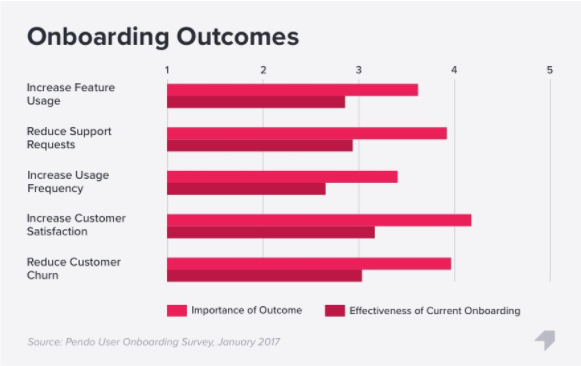A new customer installs your product. They have already been through the trial and they’ve paid their first bill — now it’s time to onboard them! But…what does that mean?
Turns out, many companies are still struggling to determine exactly what onboarding should look like. Pendo’s recent onboarding survey asked users to rank their most important onboarding objectives, and revealed that their current onboarding program was underperforming across the top five.
Each business is different and each company has different objectives for their users. There is no ‘perfect’ onboarding strategy. To help improve some of the top pitfalls we commonly see, here are our top secrets (okay, maybe not secrets) to take into consideration when improving your onboarding experience.
Know Who You’re Targeting
A huge mistake many companies make when creating an onboarding process, is to put all users in the same bucket. In reality, each user segment has different experience levels, different backgrounds, and different roles in their company. When you only create one onboarding experience, you’re only paying attention to a single customer.
The onboarding survey revealed that over 60% of respondents did not tailor their onboarding experience for the basic segment of job role. Tailoring an onboarding experience isn’t simple. It requires an evaluation of not only user personas, but also, of how each persona uses (or should use) the platform for success. It’s critical to understand how different people use and interpret a feature. A marketing persona will translate the usage of a feature much differently than someone who is more customer facing, like a success persona.
Another segment commonly missed is new users from an existing account. Whether it’s a role change or a newly added team member, there is a responsibility to onboard all new users to the platform. In this article, we took a look at some of the core differences in onboarding new users from new accounts versus new users from existing accounts.
Quality > Quantity
It’s important to remember that at the end of the day, your users are people. Not only that, they’re people at work. They get distracted and have other priorities that don’t involve walking through a 12 step onboarding program.
The most successful onboarding programs are ones that deeply understand the user journey with the application. This involves a more in-depth process than simply announcing features in a light box. Separating steps by evaluating the number of user log-ins, or based on past behavior, will provide not only a better onboarding experience, but one that users actually pay attention to.
This will also allow for a continuous learning process as new features are released or changes are made within the application.
Make it a Team Effort
Like NPS, we’ve seen that many companies think of user onboarding as a task for customer success. In fairness, keeping customers successful can be positively affected through great onboarding. But, it shouldn’t be an objective solely for the customer success manager.
From our research, we’ve found that firms who involve product management in their onboarding process had a much more success program. It makes sense. Product managers are building products and features based on user feedback. They have the deepest insights in not only what a feature does, but why it’s important to the end user. Product management can be utilized throughout the entire onboarding process to ensure that users are not only learning the tool initially, but are continually engaging with the product with each new feature release.
Every business is different, but we have found that only when you incorporate all departments into the onboarding strategy, can you create a successful program. Read more about our four-part, company-wide journey to better onboarding here.
Track Program Success
The number one reason that most companies do not invest enough in onboarding is a lack of data to back it up. In order to qualify any new spend, objectives should be set. So it’s critical that goals for onboarding be put in place that accurately reflect metrics that a firm cares about. Is it time spent in product? Average use of specific features? Certain actions or objectives completed in x amount of time? Whatever the goals are, they should be tracked and maintained through onboarding.
This will not only provide context to continue to build out an onboarding strategy, but can also provide insights into user behavior.



